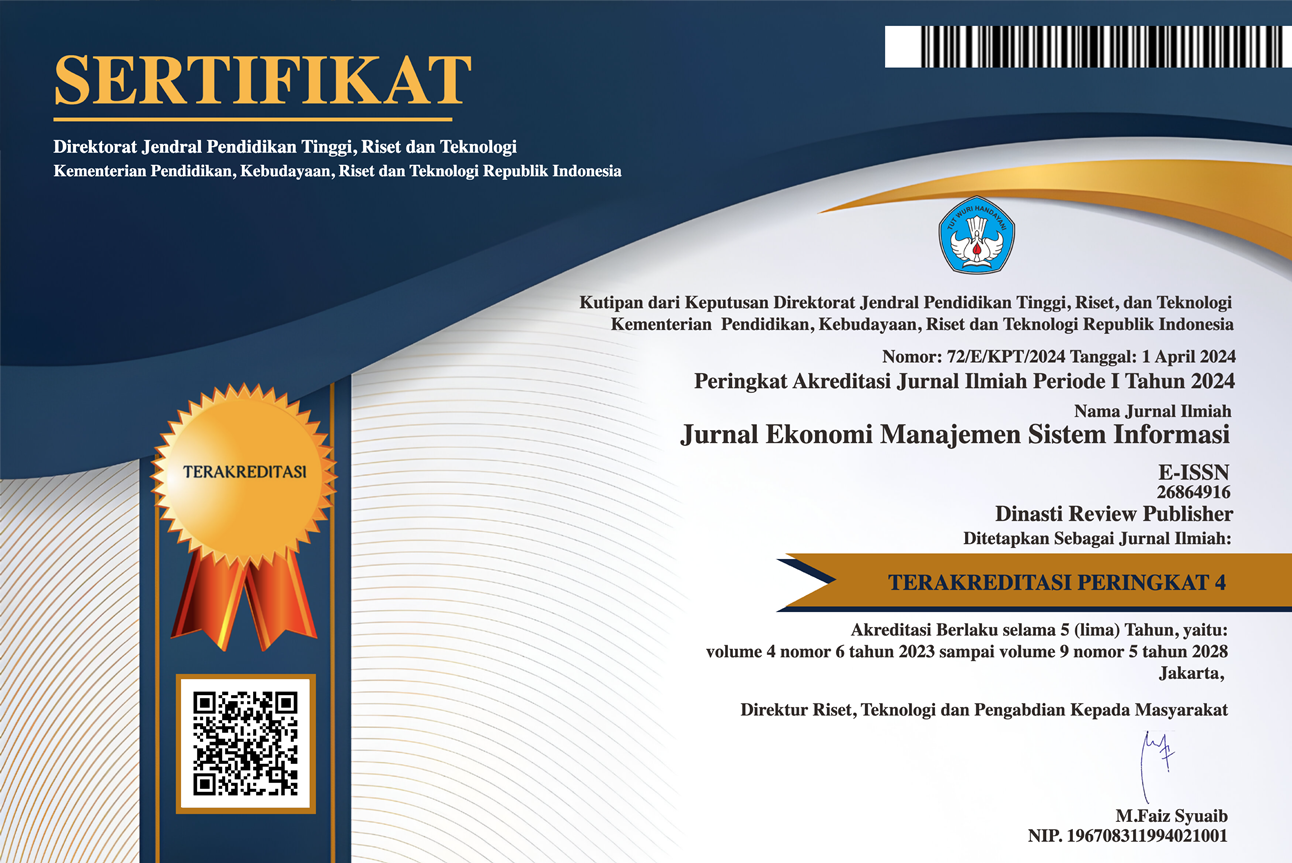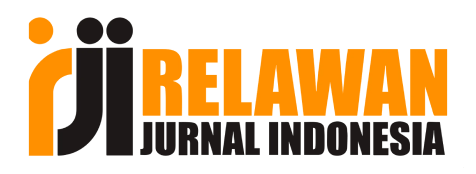Peran Manajemen Strategik dalam Optimalisasi Sistem Informasi Perusahaan: Tinjauan Literatur
DOI:
https://doi.org/10.38035/jemsi.v6i5.5014Keywords:
Manajemen Strategik, Sistem Informasi, Optimalisasi, Transformasi DigitalAbstract
Manajemen strategik berperan penting dalam optimalisasi sistem informasi perusahaan guna meningkatkan efisiensi operasional, daya saing, dan ketahanan bisnis. Artikel ini bertujuan untuk mengkaji peran manajemen strategik dalam penerapan sistem informasi perusahaan melalui tinjauan literatur yang komprehensif. Studi ini menelusuri berbagai pendekatan dalam penerapan sistem informasi yang selaras dengan strategi bisnis, termasuk perencanaan strategis, integrasi teknologi informasi, dan pengelolaan perubahan organisasi. Hasil tinjauan menunjukkan bahwa pendekatan manajemen strategik yang efektif dapat meningkatkan adopsi sistem informasi yang lebih optimal, mengurangi hambatan implementasi, serta memberikan keuntungan kompetitif bagi perusahaan. Simpulan dari studi ini menegaskan bahwa sinergi antara manajemen strategik dan sistem informasi merupakan faktor kunci dalam keberhasilan transformasi digital di organisasi.
References
A. Alamsyah and S. Syahrir, Blockchain and Smart-Contract Technologies for Innovative Applications, no. April. 2024. doi: 10.1007/978-3-031-50028-2.
A. Mutedi, A. M. Widodo, G. Firmansyah, and B. Tjahjono, “Enterprise Architecture Business Model Planning Using EAP Framework (Case Study: PT. Gempita Cahaya Makmur),” vol. 3, pp. 1–9, 2024.
B. C. Stahl and D. Eke, “The ethics of ChatGPT – Exploring the ethical issues of an emerging technology,” Int. J. Inf. Manage., vol. 74, no. August 2023, p. 102700, 2024, doi: 10.1016/j.ijinfomgt.2023.102700.
C. Riedinger, S. Zimmermann, and C. Rentrop, “The Operationalization of Strategic Alignment: Driving IT Value through Business-IT Dialogues,” pp. 6037–6046, 2025.
D. Fuerstenau and T. J. Winkler, “Bridging Business and IT Through Low-Code / No-Code: Insights into Business- IT Collaboration in Enterprise Citizen Developer Programs Bridging Business and IT Through Low-Code / No-Code: Insights into Business-IT Collaboration in Enterprise Citizen Developer Programs,” no. January, 2025, doi: 10.24251/HICSS.2025.054.
D. O. Oyejobi, A. A. Firoozi, D. B. Fernández, and S. Avudaiappan, “Integrating circular economy principles into concrete technology: Enhancing sustainability through industrial waste utilization,” Results Eng., vol. 24, no. July, 2024, doi: 10.1016/j.rineng.2024.102846.
Daniel Ajiga, Patrick Azuka Okeleke, Samuel Olaoluwa Folorunsho, and Chinedu Ezeigweneme, “The role of software automation in improving industrial operations and efficiency,” Int. J. Eng. Res. Updat., vol. 7, no. 1, pp. 022–035, 2024, doi: 10.53430/ijeru.2024.7.1.0031.
H. Supriadi, M. R. Istambul, and P. Parlindungan, “Enterprise Architecture Planning Bagi Desa Digital Di Kabupaten Sumedang,” INTI Nusa Mandiri, vol. 18, no. 2, pp. 129–136, 2024, doi: 10.33480/inti.v18i2.4990.
H. Yang and M. Umair, “Polluting industries: Does green industrial policy encourage green innovation? Chinese perspective evidence,” Heliyon, vol. 10, no. 17, p. e36634, 2024, doi: 10.1016/j.heliyon. 2024. e36634.
J. Nuerk and F. Da?ena, “Systems Engineering Methodology for Digital Supply Chain Business Models,” Syst. Eng., pp. 1–27, 2025, doi: 10.1002/sys.21802.
J. T. Licardo, M. Domjan, and T. Orehova?ki, “Intelligent Robotics—A Systematic Review of Emerging Technologies and Trends,” Electron., vol. 13, no. 3, 2024, doi: 10.3390/electronics13030542.
K. L. Lee, C. X. Teong, H. M. Alzoubi, M. T. Alshurideh, M. El Khatib, and S. M. Al-Gharaibeh, “Digital supply chain transformation: The role of smart technologies on operational performance in manufacturing industry,” Int. J. Eng. Bus. Manag., vol. 16, pp. 1–19, 2024, doi: 10.1177/18479790241234986.
L. Ghorbani et al., “Examining the Compatibility of Luftman’s Model to Measure the Maturity of Information Technology Alignment with Organizational Strategies in Iranian Sports Federations,” 2024.
M. Al Bashar and H. Ahmed, “the Impact of Advanced Robotics and Automation on Supply Chain Efficiency in Industrial Manufacturing: a Comparative Analysis Between the Us and Bangladesh,” Glob. Mainstream J. Arts, Lit. Hist. Educ., vol. 3, no. 3, pp. 28–41, 2024, doi: 10.62304/jbedpm. v3i03.86.
M. L. Al Fath and M. N. Sitokdana, “Perancangan Arsitektur Teknologi Informasi di Dinas KOMINFO Kabupaten Semarang Menggunakan Enterprise Architecture Planning,” J. Indones. Manaj. Inform. dan Komun., vol. 5, no. 1, pp. 38–47, 2024, doi: 10.35870/jimik.v5i1.419.
M. Tao, S. Poletti, L. Wen, and M. S. Sheng, “Modelling the role of industrial structure adjustment on China’s energy efficiency: Insights from technology innovation,” J. Clean. Prod., vol. 441, no. July 2023, p. 140861, 2024, doi: 10.1016/j.jclepro.2024.140861.
M. W. N. Manafe, A. Rizani, E. Purnawati, and I. Harsono, “Analysis of the Influence of Technical Expertise, Market Orientation, Social Capital, and Innovation on the Performance of Micro and Small Businesses in the Technology Sector,” Int. J. Business, Law, Educ., vol. 5, no. 1, pp. 983–995, 2024, doi: 10.56442/ijble. v5i1.493.
M. Zulfani and A. W. R. Emanuel, “Perancangan Model Enterprise Architecture Planning pada PT. Bestari Kalimantan,” J. JTIK (Jurnal Teknol. Inf. dan Komunikasi), vol. 8, no. 2, pp. 341–350, 2024, doi: 10.35870/jtik. v8i2.1795.
N. Ayusra, H. Sujaini, and E. Faja, “Implementasi Metode Enterprise Architecture Planning (EAP) Dalam Perancangan Cetak Biru Sistem Informasi Universitas Tanjungpura Implementation of the Enterprise Architecture Planning (EAP) Methodology in Designing the Information System Blueprint for Universitas Tanjungpura,” vol. 03, no. 1, pp. 20–31, 2024, doi: 10.26418/juara. v3i1.84654.
N. Messerschmidt, S. Schlauderer, and S. Overhage, “Towards Achieving Organizational Agility in Software Development: Identifying Issues and Organizational Alignment Strategies,” pp. 7454–7463, 2025.
N. Phan, A. Kristianto, J. Kendrico, and W. J. Alexander, “Perencanaan Enterprise Architecture Sistem Informasi pada Akademik: Studi Literatur,” JDMIS J. Data Min. Inf. Syst., vol. 2, no. 2, pp. 50–58, 2024, doi: 10.54259/jdmis. v2i2.1877.
P. Bhosale, “Data Consistency Models in Distributed Systems: CAP Theorem Revisited,” vol. 14, no. 3, pp. 1–11, 2023.
Temilade Abass, Esther Oleiye Itua, Tabat Bature, and Michael Alurame Eruaga, “Concept paper: Innovative approaches to food quality control: AI and machine learning for predictive analysis,” World J. Adv. Res. Rev., vol. 21, no. 3, pp. 823–828, 2024, doi: 10.30574/wjarr.2024.21.3.0719.
Downloads
Published
How to Cite
Issue
Section
License
Copyright (c) 2025 Muhammad Sanul Akbar

This work is licensed under a Creative Commons Attribution 4.0 International License.
Hak cipta :
Penulis yang mempublikasikan manuskripnya di jurnal ini menyetujui ketentuan berikut:
- Hak cipta pada setiap artikel adalah milik penulis.
- Penulis mengakui bahwa Jurnal Ekonomi Manajemen Sistem Informasi (JEMSI) berhak menjadi yang pertama menerbitkan dengan lisensi Creative Commons Attribution 4.0 International (Attribution 4.0 International CC BY 4.0) .
- Penulis dapat mengirimkan artikel secara terpisah, mengatur distribusi non-eksklusif manuskrip yang telah diterbitkan dalam jurnal ini ke versi lain (misalnya, dikirim ke repositori institusi penulis, publikasi ke dalam buku, dll.), dengan mengakui bahwa manuskrip telah diterbitkan pertama kali di Jurnal Ekonomi Manajemen Sistem Informasi (JEMSI).











































































